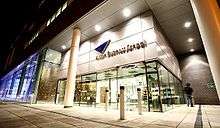Aston University
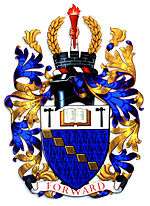 | |||||||||||||||||||||||
| Motto | Forward | ||||||||||||||||||||||
|---|---|---|---|---|---|---|---|---|---|---|---|---|---|---|---|---|---|---|---|---|---|---|---|
| Type | Public | ||||||||||||||||||||||
| Established | 1895 (granted University Status by Royal Charter in 1966)[1] | ||||||||||||||||||||||
| Endowment | £2.95 m[2] | ||||||||||||||||||||||
| Chancellor | Sir John Sunderland | ||||||||||||||||||||||
| Vice-Chancellor | Alec Cameron | ||||||||||||||||||||||
| Students | 11,065 (2014/15)[3] | ||||||||||||||||||||||
| Undergraduates | 8,690 (2014/15)[3] | ||||||||||||||||||||||
| Postgraduates | 2,375 (2014/15)[3] | ||||||||||||||||||||||
| Location |
Birmingham, UK Coordinates: 52°29′10″N 1°53′22″W / 52.4860°N 1.8895°W | ||||||||||||||||||||||
| Campus | 60 acres (240,000 m2), urban | ||||||||||||||||||||||
| Colours |
Black and Red | ||||||||||||||||||||||
| Affiliations |
ACU CDIO Initiative EUA Universities UK AACSB M5 Universities | ||||||||||||||||||||||
| Website |
www | ||||||||||||||||||||||
 | |||||||||||||||||||||||
Aston University is a public research university situated at Gosta Green, in the city centre of Birmingham, England. Aston began as the Birmingham Municipal Technical School in 1895, evolving into the UK’s first College of Advanced Technology in 1956.[4] Aston University received its royal charter from Queen Elizabeth II on 22 April 1966.
In 2016, Aston was ranked in the top 33 universities in the UK by all three major league tables, and also received recognition Times Higher Education for the second best teaching quality in the UK.[5] Aston was ranked by QS as the 42nd best university in the world under 50 years old in 2015.
Aston pioneered the integrated placement year concept over 50 years ago,[6][7][8] with more than 70% of Aston students taking a placement year, the highest percentage in the UK.[9]
History
The origins of Aston University are a School of Metallurgy formed in the Birmingham and Midland Institute in 1875. The Birmingham Municipal Technical School separated from the Institute in 1895, teaching chemistry, physics, metallurgy and electrical engineering. In 1911, commercial classes were introduced and grew into an independent School of Commerce by 1916.[10] The school changed its name in 1927 to the Birmingham Central Technical College,[10] to reflect its changing approach to teaching technology.
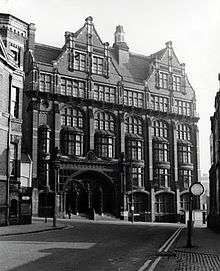
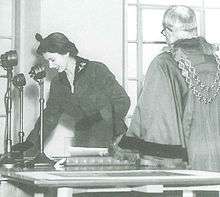
In 1951, the Technical College was renamed the College of Technology, Birmingham[10] and work began on the Main Building at Gosta Green. In 1956, it became the first elite designated College of Advanced Technology and underwent a major expansion.[10] It moved into buildings that were constructed between 1949 and 1955 to a design by Ashley & Newman. Princess Margaret laid one of the first foundation stones at the base of the new building in 1951. The building is one of Europe’s largest, freestanding brick buildings.[13] In 1955, the College of Advanced Technology was opened by Her Majesty The Queen.[14] The college expanded again to a design by the City Architect of Birmingham Alwyn Sheppard Fidler between 1957 and 1965.[15]
It officially became the University of Aston in Birmingham on receipt of its Royal Charter on 22 April 1966 and the first Chancellor of the University, Lord Nelson of Stafford, was installed on 10 May. The Charter of the University outlines objectives appropriate to a technological university: "to advance, disseminate and apply learning and knowledge by teaching and research, for the benefit of industry and commerce and of the community generally: and to enable students to obtain the advantage of a university education, and such teaching and research may include periods outside the University in industry or commerce or wherever the University considers proper for the best advancement of its objects." The emphasis given to the sandwich course system, and the maintenance of strong links with industry, arises naturally from the institution’s history. The motto of the University is the same as that of the City of Birmingham – Forward.[16]

Establishment of the Aston Science Park and Aston University’s contribution to the city of Birmingham was fully recognised when the area was granted its own postal address “The Aston Triangle” in 1984, emphasising the campus as an official district of Birmingham. The logo of the establishment takes from the shape of the area.[17]
Since May 2011 Sir John Sunderland has been the current Chancellor of Aston University.
Aston University hosted the British Science Festival in September 2010, said to be Europe's largest public science event.
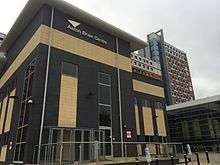
Aston University Engineering Academy
The university is a lead sponsor of Aston University Engineering Academy, a new university technical college (UTC) which opened in September 2012. The UTC is for students aged 14 to 19 wishing to pursue further study and careers in engineering, and is located at the edge of the Aston University campus.[18]
Aston Science Park
In 1983, Aston University, in partnership with Birmingham City Council and Lloyds Bank, established Birmingham Technology Ltd., which manages the Aston Science Park adjacent to the university site.
Aston Medical School
In October 2014, Aston announced plans to launch a new £60 million Aston Medical School in October 2015.[19] The University also announced a £35 million cash injection for a major upgrade of the campus, including a new £19 million revamp of Aston Business School and improvement work to the Aston Institute of Photonic Technologies and the School of Languages and Social Sciences.[20]
Campus

Established in 1895 as the Birmingham Municipal Technical School,[21] The university is situated on a 60-acre campus at Gosta Green, in the city centre of Birmingham, England.[22] As well as being home to over 3,000 students, the Aston University campus has the following amenities available: sports centres, swimming pool, 120 station gym, library, cafés, restaurants, pubs, shops, travel centre, hairdresser, health centre, dentist, places of worship, opticians, a bank, automated teller machines and plenty of outside space.
Aston University Library is on four floors and contains over 250,000 books, 800 current printed periodicals and has over 700 reader places. It provides online access to over 40 electronic databases and more than 3,400 electronic journals. The Library is open 24 hours a day to Aston students and staff during term time.
Around the campus there are also various open-access IT suites, offering computer and internet access 24 hours a day, seven days a week. They offer access to a range of software packages, database systems and computer-aided learning materials.
Sports
The Aston's sports facilities include a 25m swimming pool, sauna and steam room, two sports halls, 120 station Gym, weights and fitness rooms, two storey dance studio and 35 sports clubs. The campus also has two 3G floodlit sports pitches. Clubs train and compete, many in the British Universities and Colleges Sports (BUCS) Leagues. Off campus the University manages a 40-acre sports ground with floodlit pitches, pavilion for all outdoor sports.
Organisation and administration
Faculties and departments
All of the Aston University's faculties are based on one campus. They are organised into the following five schools:
- School of Engineering and Applied Science
- Chemical Engineering & Applied Chemistry
- Computer Science
- Electronic Engineering
- Engineering Systems and Management
- Mathematics
- Mechanical Engineering and Design
- School of Life and Health Sciences
- Audiology
- Biology
- Biomedical Science
- Optometry
- Pharmacy
- Psychology
- School of Languages and Social Sciences*
- Modern languages & translation studies
- International relations, politics & European studies
- English language
- Sociology & public policy
- Aston Business School
- Aston Law
- Economics and Strategy
- Finance and Accounting
- Marketing Group
- Operations and Information Management Group
- Work and Organisational Psychology
Coat of arms
The university's arms were granted on 18 March 1955 by Garter, Clarenceux and Norroy and Ulster Kings of Arms to the Birmingham Corporation, for use by the former College of Technology. They were designed to show the College's connection with the City and with the teaching of technology. The arms consist of a shield and crest. The shield has two sections – the field (the main background) which is coloured blue and a chief (the broad band across the top of the shield) of silver. On the field is a diagonal line of five gold diamonds joined one to the other, similar to the first quarter of the Arms of the City of Birmingham and incorporated in the Arms of the College to show its connection with the City. This was adopted by the family of Birmingham which derived its name from the then hamlet of Birmingham, and provided the Lords of the Manor from the fourteenth to the sixteenth centuries. On the chief is depicted an open book bound in red placed between two black hammers, showing the connection of the University with technology, the book representing learning and the hammers engineering and allied trades.
The crest is also designed to stress the pursuit of knowledge. It consists of a red torch held erect by a forearm between two branches of gold laurel. Having been originally worn on the helmet of a fully armed person, the crest is always placed on the top of the helm. The method of joining the crest to the helm was usually concealed by decoration and, in the University’s arms, this is effected by the use of a wreath and a crown. The wreath is silver, red and black, these colours being taken from the shield. It is surmounted by a mural crown (resembling a wall), which is reserved in modern grants for persons and organisations connected with public corporations. The cloth mantling which hangs down from the top of the helm is the survival of the cloak which was originally worn to protect the armour, coloured in the two principal colours of the shield, blue and gold.[23]
Academic dress
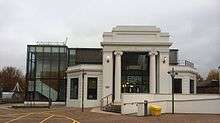
The academic dress for graduates of the University is as follows:
- Bachelor of Science, Bachelor of Engineering and Master of Engineering
- Gown: Black stuff of special design, having coat-type sleeve, narrow facings which continue round the neck and with extra wide gathers round the back
- Hood: Black stuff, modified simple shape, faced inside for three inches with University lining
- Hat: Black mortar board
- Master of Science
- Gown: Black stuff of special design, having coat-type sleeve, narrow facings which continue round the neck and with extra wide gathers round the back
- Hood: Black stuff, modified simple shape, fully lined with University lining
- Hat: Black mortar board
- Master of Philosophy
- Gown: Black stuff of special design, having coat-type sleeve, narrow facings which continue round the neck and with extra wide gathers round the back
- Hood: Blue stuff, modified simple shape, fully lined with University lining
- Hat: Black mortar board
- Doctor of Philosophy
- Gown: Claret colour cloth robe, having coat-type sleeve, narrow facings which continue round the neck and with extra wide gathers round the back
- Hood: Modified simple shape, in University Red stuff, faced inside for three inches with University lining
- Hat: Black cloth bonnet with cord and tassels of University Red
- Doctor of Science
- Gown: Same shape as for Doctor of Philosophy but in University Red, with facings on collar of University lining and gold cuffs on sleeves
- Hood: Same shape as for Doctor of Philosophy but of gold silk and fully lined with University lining
- Hat: Black velvet bonnet with cord and tassels in gold
Academic profile
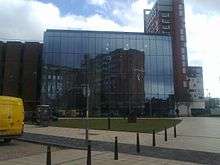
Research
In the latest 2008 Research Assessment Exercise, Aston University was ranked in the top 12 in the UK in all four of its broad subject areas, with 86% of research undertaken was described as 'internationally significant'.[24] 88% of Aston academic staff were submitted for research assessment, one of the highest proportions in the UK. According to the RAE, the university's strengths include Business and Management, General Engineering, Subjects Allied to Medicine (Optometry, Biology, Pharmacy and Psychology), Languages and European Studies.[25]
Rankings
| QS[26] (2016/17, national) | 44 | |
|---|---|---|
| QS[27] (2016/17, world) | 358 | |
| THE[28] (2016/17, national) | 49 | |
| THE[29] (2016/17, world) | 351-400 | |
| Complete[30] (2017, national) |
29 | |
| The Guardian[31] (2017, national) |
29 | |
| Times/Sunday Times[32] (2017, national) |
33 | |
Aston University has been ranked 42nd in the world’s leading universities under the age of 50.[33] The University has been rated 351-400th according to the Times Higher Education World University Rankings and 358th in the QS World University Rankings.[33] Graduate employers ranked Aston University 51st in the world for graduate employability (2012 QS World University Rankings)[34] and was ranked in the top ten of all UK universities for the percentage of graduate employment record.[25]
Aston has consistently been ranked in the top 20-40th in The Times and Complete University Guide UK rankings.[35]
In the 2011 National Student Survey, Aston's overall satisfaction score was 86%, well above the UK average of 83%. Aston also has had an 'overall satisfaction' rate above the UK average for each of the seven years of the National Student Survey so far.[25] The 2011 Performance Indicators (produced by HEFCE) showed Aston had one of the lowest drop-out rates in the UK at 3.9%.[25]
Aston students are the joint 15th most satisfied students out of 136 UK Universities, with the overall satisfaction level at 90%.[36] Aston University was responsible for educating 2.3 per cent of the UK's millionaires, placing Aston among the top 10 UK universities for producing millionaires.[37]
Aston Business School
Founded in 1947[38] Aston Business School (ABS) is one of the largest and oldest business schools in the UK.[38][39] The school was ranked 8th in the UK and 33rd in the world by QS in 2012 and it is among the top 60 of business schools in the world to hold triple accreditation.[40] ABS was the first UK business school to be awarded the prestigious EQUIS accreditation, in 1999.[41] ABS is the first institution in the UK to be allied with Beta Gamma Sigma by establishing a BGS Collegiate Chapter. In 2006 it opened a new £22m extension including new study rooms and two new lecture theatres.[42]
The business school's Masters Management course was ranked by the Financial Times in 2012 as 5th in the UK, 33rd in Europe and 36th in the world.[43] The paper also ranked Aston Business School as 4th in the world for careers in 2011.[44] In the school's most recent Research Assessment Exercise in 2008, all research areas submitted ranked in the top 9 in the UK. 45% of the research submitted was judged to be 'excellent' or 'world-leading'.[24]
Aston is 2nd in the UK for developing marketing professionals and 7th in the UK for finance professionals, based on the career outcome data of more than 313+ million LinkedIn members. The University was also 23 rd in the UK for accounting professionals.[45] According to the Complete University Guide 2016, Aston is ranked 6th for marketing, 22nd for accounting and finance, 22nd for economics and 23rd for business and management studies in the UK.
Student life
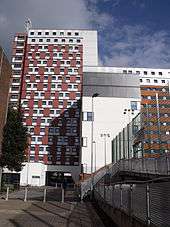
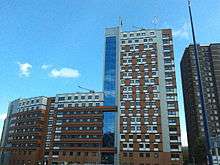
Students' Union
Aston Students' Union (SU) (formerly Guild) is a non-profit, independent charity set up with the aim of representing and supporting its members who are primarily current students at Aston University. The SU operates a number of commercial and non-commercial services including; the Advice & Representation Centre (ARC), the Aston Athletic Union which supports the university sports clubs, the Aston Societies Federation which supports a large number of non-sporting societies, the SU Shop, Copyshop and B4 Bar. The SU is funded by grant income from Aston University and by funds raised by the SU's commercial services. The SU is led by a Trustee Board consisting of elected students and external trustees. Day-to-day management is by a team of permanent staff and by an elected student team called the Executive Committee. The SU building consists of 5 floors and is located in the centre of the Aston University Campus.
On 29 November 2006, the students voted to disaffiliate the Guild (now Union) from the National Union of Students, but voted to re-affiliate on 26 November 2014.[46]
Student housing
All of the accommodation in Aston University is now en-suite – 3,000 rooms in total. In the 1970s, three tower blocks containing student accommodation were constructed on Aston University campus; Dalton, Lawrence and Stafford Towers. In April 2007, Aston University submitted a planning application for demolition of the three 1970s towers and to replace them with new student accommodation blocks as well as apartments for tutors, retail units and administrative offices. Lawrence and Dalton Towers were demolished on 8 May 2011.[47] Stafford Tower, Gem Sports Centre and Lakeside Conference Centre were demolished on 28 April 2014 to make way for a new entrance to Aston University and a five-acre green space. The new landscaped area includes a new walkway into the university from the city centre and a pavilion, to be used for teaching and as a catering facility for outdoor events. The new buildings are named the William Murdoch, the James Watt, the Harriet Martineau and the Mary Sturge Residences.[48]
Another addition to Aston University student dwelling stock is the Lakeside complex on campus which was completed in August 1999.
Notable people
List of Chancellors
- Lord Nelson of Stafford (May 1966 – September 1979)
- Sir Adrian Cadbury (September 1979 – September 2004)
- Michael Bett (September 2004 – May 2011)
- John Sunderland (Since May 2011)
List of Vice-Chancellors
- Peter Venables (April 1966 - July 1969)
- Sir Joseph Pope (August 1969 - September 1979)
- Frederick W. Crawford (July 1980 - August 1996)
- Michael T. Wright (September 1996 - November 2006)
- Dame Julia King (November 2006 – September 2016)
- Alec Cameron (September 2016 – Present)
Alumni
- Chris Banks, British businessman
- Keith Bradley, Baron Bradley, Labour Party politician and life peer
- Rob Brighouse, Managing Director Chiltern Railways[49]
- Frankie Boyle, Stand-up, Television
- Anthony Cheung, Secretary for Transport and Housing in Hong Kong
- Stewart Clegg, Australian sociologist
- Paul Drayson, Baron Drayson, vaccine manufacturer and Minister of State for Science, Drayson Racing Driver
- Simon D'Ujanga, State Minister for Energy in Uganda
- Veronica German, Scientist, Member of the National Assembly for Wales
- Malcolm Harbour, British politician
- Tony Hayward, Former chief executive of BP Group
- Abdollah Jassbi, President of Azad University
- Laura Jones, BBC Journalist
- Mohammad Nizar Jamaluddin, Former Chief Minister of the state of Perak
- Ravi Kant, Vice Chairman of TATA Motors, India[50]
- Ashok Kumar, Labour Party politician
- Kevin Morley, Former Managing Director of the former Rover Group
- Ivan Noble, BBC journalist
- Terry Pitt, Political adviser and former Member of the European Parliament
- Phil Popham, Global Operations Director for the global Jaguar Land Rover business
- Rahul Potluri, Founder of ACALM, Doctor, Researcher, Scientist
- John Rickard, Former Chief Economic Advisor to the British Government
- Nic Robertson, Senior International Correspondent at CNN
- Jeff Rooker, Baron Rooker, Labour Peer
- Adam Ryland, British programmer
- Claire Curtis-Thomas, British Labour Party politician and former MP
- Gregor Townsend MBE, Scottish and British Lions Rugby Union Player[51]
- Kate Walsh, Television presenter
- Robert Walter, Conservative MP
- Kevin Warwick, Professor of cybernetics and Deputy Vice-Chancellor (Research) at Coventry University
- Steve Wharton, British academic
- Mike Wright, Executive Director Jaguar Land Rover[49]
- Salma Yaqoob, Leader, and former vice-chairman, of Respect – The Unity Coalition
References
- ↑ "History and traditions". Retrieved 16 July 2015.
- ↑ "Financial Statements 2014-15" (PDF). Aston University. p. 25. Retrieved 30 October 2016.
- 1 2 3 "2014/15 Students by HE provider, level, mode and domicile" (XLSX). Higher Education Statistics Agency. Retrieved 19 January 2016.
- ↑ Neil Handley. "Birmingham - Central Technical College and Aston University". Retrieved 16 July 2015.
- ↑ http://www.aston.ac.uk/news/releases/2016/june/new-rankings-rate-aston-second-best-in-uk/
- ↑ "Aston University team up with tech firm for IT degree". birminghampost. 8 March 2014. Retrieved 16 July 2015.
- ↑ "50th Anniversary: Sir James Gracie Q&A". Retrieved 16 July 2015.
- ↑ https://www.heacademy.ac.uk/sites/default/files/graduates-for-industry-aston.pdf
- ↑ "Aston University". Complete University Guide. Retrieved 2014-04-27.
- 1 2 3 4 "History and Traditions". Aston University. 2008. Archived from the original on 19 December 2008. Retrieved 2008-12-31.
- ↑ "The Early Years". Retrieved 16 July 2015.
- ↑ "1950s". Retrieved 16 July 2015.
- 1 2 "Midlands Business News New era at Conference Aston with the help of Overbury - Midlands Business News". Midlands Business News. Retrieved 16 July 2015.
- ↑ "1950s". Aston.ac.uk. Retrieved 2014-04-27.
- ↑ Foster, Andy (2007) [2005]. Birmingham. Pevsner Architectural Guides. Yale University Press. p. 195. ISBN 978-0-300-10731-9.
- ↑ "History and traditions". Aston.ac.uk. Retrieved 2014-04-27.
- ↑ "1980s". Aston.ac.uk. Retrieved 2014-04-27.
- ↑ "Aston University | Aston University Engineering Academy". Auea.co.uk. Retrieved 2014-04-27.
- ↑ "Aston Medical School FAQ". Retrieved 16 July 2015.
- ↑ Jon Griffin (17 October 2014). "New Aston University business school after £35m boost". birminghampost. Retrieved 16 July 2015.
- ↑ "Uni. finder > West Midlands > Aston University". HERO. Archived from the original on 12 April 2007. Retrieved 2007-03-24.
- ↑ Tarleton, Alice (1 August 2006). "Aston University". The Independent. A-Z Unis & Colleges. London. Archived from the original on 26 September 2006. Retrieved 2007-03-24.
- ↑ "Aston University Arms". Archived from the original on 17 July 2015. Retrieved 16 July 2015.
- 1 2 "Aston's performance in the Research Excellence Framework". Retrieved 16 July 2015.
- 1 2 3 4 "Aston University". Retrieved 16 July 2015.
- ↑ "QS World University Rankings 2016/17 - United Kingdom". Quacquarelli Symonds Ltd. Retrieved 7 September 2016.
- ↑ "QS World University Rankings 2016/17". Quacquarelli Symonds Ltd. Retrieved 7 September 2016.
- ↑ "World University Rankings 2016-17 - United Kingdom". Times Higher Education. Retrieved 21 September 2016.
- ↑ "World University Rankings 2016-17". Times Higher Education. Retrieved 21 September 2016.
- ↑ "University League Table 2017". The Complete University Guide. Retrieved 25 April 2016.
- ↑ "University league tables 2017". The Guardian. 23 May 2013. Retrieved 23 May 2016.
- ↑ "The Times and Sunday Times University Good University Guide 2017". Times Newspapers. Retrieved 23 September 2016.
- 1 2 "QS World University Rankings 2015". Top Universities. Retrieved 2016-10-30.
- ↑ Birmingham Chamber Archived 27 September 2013 at the Wayback Machine.
- ↑ "Aston University". Top Universities. 2012-12-06. Retrieved 2014-04-27.
- ↑ "Students rate Aston highly in National Student Survey". Retrieved 16 July 2015.
- ↑ "Top 10 universities for joining the super-rich". Telegraph.co.uk. 26 July 2012. Retrieved 16 July 2015.
- 1 2 Archived 16 April 2008 at the Wayback Machine.
- ↑ "The pope as a turnaround CEO". The Economist.
- ↑ "Global 200 Business Schools Report - TopMBA.com" (PDF). TopMBA.com. Retrieved 16 July 2015.
- ↑ Nick Pandya. "Aston Business School". the Guardian. Retrieved 16 July 2015.
- ↑ "Aston Business School, Aston University | StudyLink". Pg.studylink.co.uk. Retrieved 2014-04-27.
- ↑ "Business school rankings from the Financial Times - Aston Business School". Rankings.ft.com. Retrieved 2014-04-27.
- ↑ "Aston Business School is 4th in the world for careers". .aston.ac.uk. 2011-09-19. Retrieved 2014-04-27.
- ↑ "Aston rated 'Top 10' in LinkedIn Rankings". Retrieved 16 July 2015.
- ↑ "Aston Students' Union re-joins NUS". NUS. Retrieved 26 November 2014.
- ↑ "BBC News - Aston University tower blocks demolished". Bbc.co.uk. 2011-05-08. Retrieved 2014-04-27.
- ↑ Archived 25 July 2013 at the Wayback Machine.
- 1 2 "Business Directors join Advisory Board". .aston.ac.uk. 2013-03-05. Retrieved 2014-04-27.
- ↑ "Ravi Kant - Forbes". People.forbes.com. 2012-04-18. Retrieved 2014-04-27.
- ↑ "Aston University, Birmingham - A-Z Unis & Colleges - Getting Into University". The Independent. 2013-06-06. Retrieved 2014-04-27.
External links
| Wikimedia Commons has media related to Aston University. |
